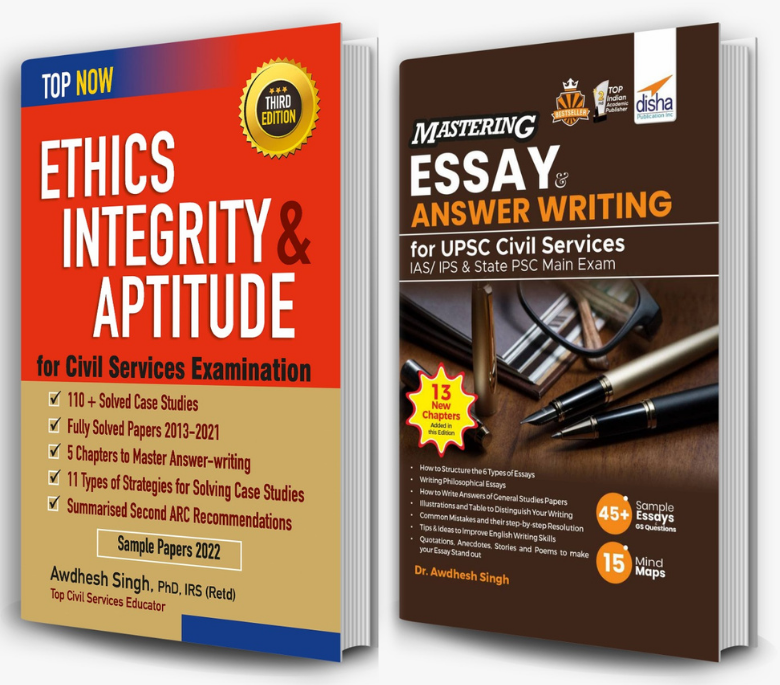Essay and Answer Writing → Model Essays
Topics
All
Civil Services in India (26)
Ethics, Integrity and Aptitude
» Chapters from Book (11)
» Case Studies (8)
Solved Ethics Papers
» CSE - 2013 (18)
» CSE - 2014 (19)
» CSE - 2015 (17)
» CSE - 2016 (18)
» CSE - 2017 (19)
» CSE - 2018 (19)
» CSE - 2019 (19)
» CSE - 2020 (19)
» CSE - 2021 (19)
» CSE -2022 (17)
» CSE-2023 (17)
Essay and Answer Writing
» Quotes (34)
» Moral Stories (18)
» Anecdotes (11)
» Beautiful Poems (10)
» Chapters from Book (5)
» UPSC Essays (40)
» Model Essays (38)
» Research and Studies (4)
Economics (NCERT) Notes
» Class IX (14)
» Class X (16)
» Class XI (55)
» Class XII (53)
Economics Current (51)
International Affairs (20)
Polity and Governance (61)
Misc (77)
Select Topic »

Civil Services in India (26)
Ethics, Integrity and Aptitude (-)
» Chapters from Book (11)
» Case Studies (8)
Solved Ethics Papers (-)
» CSE - 2013 (18)
» CSE - 2014 (19)
» CSE - 2015 (17)
» CSE - 2016 (18)
» CSE - 2017 (19)
» CSE - 2018 (19)
» CSE - 2019 (19)
» CSE - 2020 (19)
» CSE - 2021 (19)
» CSE -2022 (17)
» CSE-2023 (17)
Essay and Answer Writing (-)
» Quotes (34)
» Moral Stories (18)
» Anecdotes (11)
» Beautiful Poems (10)
» Chapters from Book (5)
» UPSC Essays (40)
» Model Essays (38)
» Research and Studies (4)
Economics (NCERT) Notes (-)
» Class IX (14)
» Class X (16)
» Class XI (55)
» Class XII (53)
Economics Current (51)
International Affairs (20)
Polity and Governance (61)
Misc (77)

National Urban Digital Mission
In February 2021, the Central government launched the National Urban Digital Mission aimed to create a digital infrastructure for cities in the country. According to the Union Housing and Urban Affairs Ministry (MoHUA) this will institutionalise a citizen-centric and ecosystem-driven approach to urban governance and service delivery in cities by 2022, and across all cities and towns by 2024. The NUDM will create a shared digital infrastructure that can consolidate and cross-leverage the various digital initiatives of the MoHUA, enabling cities and towns across India to benefit from holistic and diverse forms of support, and also keeping in mind local challenges.
Recent developments
In July 2021 it was announced that the National Urban Digital Mission will connect nearly 2,535 cities. In addition to completing 725 km of metro railway, 1,060 km are being constructed across 18 cities.
What is digitization?
Digitization is the process by which analogue content is converted into a sequence of 1s and 0s and put into binary code to be readable by the computer. Digital information also has common characteristics and qualities regardless of whether the content is stored on DVD, CD or other digital storage media. It can be linked to other materials to create multimedia. It is not dependent upon spatial or temporal barriers or hierarchies, it can be copied limited times without degradation of the original. Digitization is also a means of creating resources that can be re-purposed for unforeseen uses in future. Changing trends in research may alter the demand for item in collection. Digitization helps business grow at a fraction of the cost. A proper digitalization plan can help reinvent processes, improve quality and promote consistency.
The NUDM
34% of India’s population lives in urban areas, with a growth rate of 2.4% in the 2010-18 period. The level of urbanization across states is asymmetric. As per 2011 census, Tamil Nadu (48.4%) was the most urbanized among major states, followed by Kerala (47.7%), Maharashtra (45.2%) and Gujarat (42.6%). Moreover, Indian cities suffer from inefficiencies of service and severe stress on infrastructure. As India continues on its trajectory of growth, the quality of its urbanization will become paramount. This requires a shift from business as usual to a long-term, integrated approach towards economic growth and urbanization. There are over 4,400 statutory towns and cities in India with around 40 crore inhabitants today. At the current rate of growth, urban population in India is estimated to reach a staggering 60 crore by 2030.
National Urban Digital Mission will create the space to harness synergies from the domain of urban and technology towards creating a citizen-centric governance. The National Urban Digital Mission (NUDM) will create a shared digital infrastructure for urban India, working across the three pillars:
1. People
2. Process
3. platform
It will institutionalise a citizen-centric and ecosystem-driven approach to urban governance and service delivery in 2022 cities by 2022, and across all cities and towns in India by 2024.
NUDM is citizen-centric, ecosystem-driven, and principles-based in both design and implementation. NUDM has articulated a set of governing principles, and the technology design principles of the National Urban Innovation Stack (NUIS). The principles in turn give rise to standards, specifications, and certifications, across the three pillars.
The current strong public digital infrastructure - including Aadhaar, Unified Payments Interface and wide reach of the Internet and mobile phones - provides a strong platform for establishing the building blocks of NUDM. The objectives include:
·create shared digital infrastructure
·catalyse an urban national open digital ecosystem (u-NODE)
·enforce the adoption of open standards by all stakeholders
·create single source of truth in respect of urban assets, service delivery, urban data and actors
·promote the development of nationally scalable application systems with a special focus on achieving the Sustainable Development Goals
·adopt the best principles of cooperative federalism while working with the States, Union Territories & ULBs
·enhancing the efficiency and effectiveness of governance
·strengthen existing urban systems and applications, by ensuring their conformity with the defined standards and integration with the proposed NUDM.
The NUDM will be anchored by the Centre for Digital Governance (CDG) at the National Institute of Urban Affairs (NIUA). The Governance of NUDM will be organised at 3 levels:
·Apex Committee: to track scheme progress and governance, this body will be chaired by the Secretary, MoHUA
·Technical Task Force: to review the building of the shared digital infrastructure and make recommendations, this body will be chaired by an eminent technology expert
·Program Steering Committees: a program steering committee for each of the various programs to be operationalised under NUDM.
Benefits and significance
NUDM is designed to respond to the local challenges of the cities and to address citizen needs. It is created with a vision to improve service delivery, build accountability and transform governance and accelerate adoption of digital urban governance. The approach is centred in a manner that is responsive and customized to specific needs of each city or town.
·Improved ease of living
·Ease of working for field-level functionaries through digital tools
·Better decision support systems to manage cities better
·Easier access to information and a streamlined way of connecting with urban departments
·Lowered costs for innovation
·Improved ease of doing business through time-bound approval of applications
·Reduced barriers to entry for startups and MSMEs
·Achieve State priorities in a targeted manner
·Improved financial management, fund-utilization and budgeting
·Improved targeting of policy through analysing data
Other initiatives
1. India Urban Data Exchange (IUDX): in partnership between the Smart Cities Mission and the Indian Institute of Science (IISc), Bengaluru to address the problem of data silos, both within and across cities.
2. Smart Cities Mission 2.0: has been redesigned to serve as a single stop for all Smart Cities initiatives.
3. Smart Code Platform: a repository of open-source code for various solutions and applications for urban governance
4. Geospatial Management Information System (GMIS): a web-based, spatially-enabled management tool, providing one-stop access to information.
Challenges
NUDM as a policy relies heavily on digital information and digitization of all platforms. The current state of affairs suggests that there is poor planning and a lack of IT resources as well as manpower to pull this initiative. Such large scale digital activity runs the risk of breech of data and sensitive information. Moreover, digital technology is not accessible to every citizen which creates digital divide due to a lack of connectivity. Funding at a huge scale and investment is required for such a massive programme and there has been no clarity on the resources for funding yet.
Way forward – conclusion
The real estate sector has been stressed for quite some time, but it has started showing signs of improvement. The sector contributes an average of 7% to the nation’s GDP and is expected to reach 10% by 2025. Since its launch in 2015, the Smart Cities Mission has made significant strides in its efforts to ensure that the benefits of technology reach all citizens. Over the last year, the Mission has seen accelerated project implementation with Smart Cities focusing on grounding and completion of projects.
There are many ways in which the NUDM can help organise the urban mission better:
·Streamlining this massive undertaking by allocating specific work and departments to relevant groups both at the Centre and State level
·Improving the state of digital literacy in the country
·Improving infrastructure like roads and railways
·Making the growth inclusive and equal across the country
Sources:
Financial express
PIB
Nudm.mohua.nic.in
The Hindu

Looking for a One-stop Solution to prepare for ‘Ethics, Integrity, and Aptitude’ and ‘Essay and Answer Writing’ for UPSC?
Buy Dr. Awdhesh Singh’s books from the links below-
Buy Dr. Awdhesh Singh’s books from the links below-
Ethics, Integrity & Aptitude for Civil Services Examination
Amazon - https://amzn.to/3s1Qz7v
Flipkart - https://bit.ly/358N2uY
Mastering Essay & Answer Writing for UPSC Civil Services
Amazon - https://amzn.to/3JELE2h
Flipkart - https://bit.ly/3gVIwmv
| Related Articles |
| Recent Articles |
